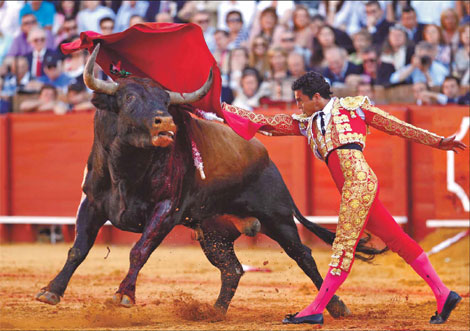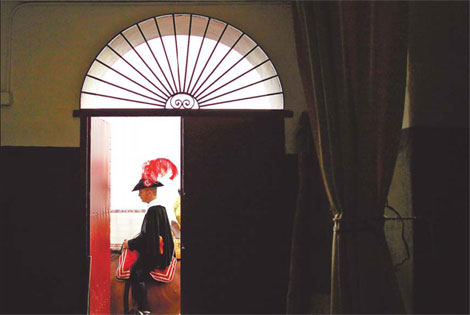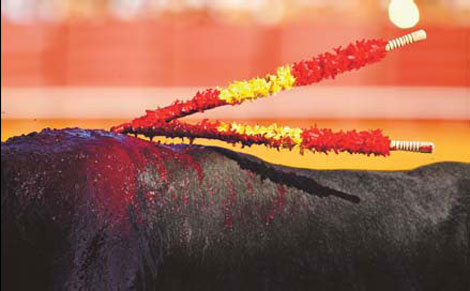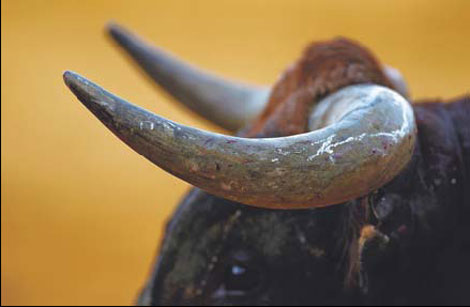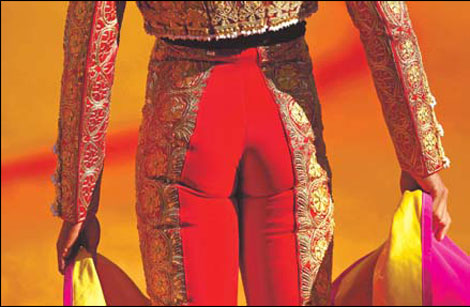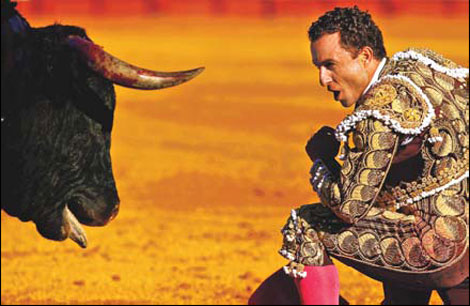Dance with death
|
Mexican matador Israel Tellez, who recently recovered from being gored by a bull in February, re-establishes his confidence in the Maestranza. Bullfighting in Mexico is similar in style to Spain, as the Mexicans' obsession with the blood sport started 400 years ago during the Spanish occupation. Photos by Reuters |
|
A Spanish official makes the rounds on his horse before the start of a bullfight. Photos by Reuters |
|
Two banderillas, decorated barbed darts that are thrust into the animal's shoulder muscles, goads it into being more aggressive. Photos by Reuters |
|
The sharp horns of an angry bull can be lethal weapons in the ring. Photos by Reuters |
|
Torero costumes, inspired by 17th- century Andalusian clothing, are designed to dazzle. Photos by Reuters |
|
Spanish matador Rafaelillo faces off with a bull. Drawing the animal's ire tests the matador's skill. Photos by Reuters |
Drama, color - and a healthy dose of fear - add spice to the centuries-old tradition of bullfighting in Spain.
The kick-off of a new bullfighting season in Spain presents modern matadors in a dazzling drama in colorful arenas, but it also showcases the high risks of a potentially deadly encounter.
One of the most impressive showcases of the art: The Maestranza bullring of Seville, among the oldest and most significant venues in the history of bullfighting. Located in southern Spain, the bullring took more than a century to build after construction began in 1749 - though bullfights only began there in 1765.
Commentators say a matador has not really "made it" until he has triumphed here at the Plaza de Toros de la Real Maestranza de Caballera de Sevilla (Bullring of the Royal Equestrian Society of Noblemen). All of Spain's great bullfighters - Belmonte, Manolete, Paquirri, Curro Romero and Espartaco - have wowed the crowds annually at the Feria de Abril (Festival of April), Easter Sunday and sporadic events through October.
The Spanish occupation of Mexico led to the rise of bullfighting in that country. Also known as fiesta brava, the sport has been one of the most popular there for the last 400 years. In both Mexico and Spain, matadors perform graceful moves, often using a piece of red cloth, to attract a bull. The show can also include rodeos, pig chases and dances, usually before the bullfight begins. In the end, the bull is killed with a sword.
Of course, with popularity comes controversy. Critical animal-rights activists have been especially vocal in Mexico, arguing that the "blood sport" is potentially deadly for bull and matador, also dangerous for the horses used to control where the bull runs. (At bullfights in Portugal, the bull is not killed at the end of the encounter.)
Enthusiasts insist that bullfighting is a culturally important tradition and a fully developed art form on par with painting, dancing and music. The sport has been famously celebrated in Georges Bizet's opera Carmen, in which the heroine is stabbed to death by ex-lover Don Jose after she falls in love with a toreador. Bullfighting has also been the subject of painting by Edouard Manet and Pablo Picasso - the latter now on display at the Maestranza bullring's museum.
China Daily
(China Daily 05/22/2011 page6)


